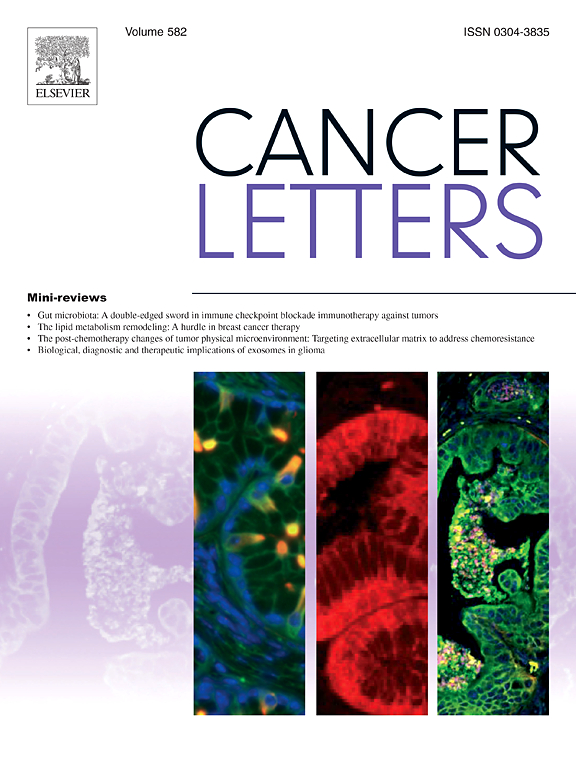PAF signaling axis functions as biomarker or target for esophageal squamous cell carcinoma diagnosis or treatment
IF 9.1
1区 医学
Q1 ONCOLOGY
引用次数: 0
Abstract
Dysregulated lipid metabolism is one of the most extinguishing metabolic hallmarks, and contributes to tumorigenesis and tumor malignancy. Platelet-activating factor (PAF), the lipid metabolite, serves as an inflammatory stimulator to induce the aggressive progression of esophageal squamous cell carcinoma (ESCC). However, whether PAF and its downstream signaling axis can function as biomarker or therapeutic target for ESCC diagnosis or treatment are still unclear. In this study, we found that plasma PAF level can reflect the lymph node (LN) metastasis status of ESCC patients. Importantly, results from Olink assay showed that several cytokines in plasma, such as interleukin-8 (IL-8), C-X-C motif chemokine ligand 1 (CXCL1), CXCL5, or CXCL11 were positively related with the LN metastasis status of ESCC patients, the expression of these cytokines was also tightly correlated with that of PAF in the plasma from LN metastatic ESCC patients. Results from RNA-seq in ESCC cell lines and immunohistochemistry (IHC) in clinical ESCC samples showed that PAF signaling effectively induced the expression of these cytokines and some tumor-promoting molecules in ESCC. Therapeutically, ginkgetin, a natural biflavonoid isolated from Ginkgo biloba L, inhibited the PAF-mediated Janus kinase 2 (JAK2)/Signal transducer and activator of transcription 3 (STAT3) activation, the expression of downstream inflammatory cytokines, glycolysis- and tumor-progression related molecules, and the malignancy of tumor cells both in vitro and in vivo, but generated barely significant toxicity towards the normal tissues of xenografted animals. Present study has illustrated that PAF can serve as biomarker for evaluation of ESCC LN metastasis, and ginkgetin could exert excellent antitumor effect on ESCC cells via suppressing PAF axis-controlled signaling pathways.
PAF信号轴可作为食管癌诊断或治疗的生物标志物或靶点
脂质代谢失调是最具破坏性的代谢标志之一,并有助于肿瘤发生和肿瘤恶性。血小板活化因子(PAF)是一种脂质代谢物,可作为炎症刺激物诱导食管鳞状细胞癌(ESCC)的侵袭性进展。然而,PAF及其下游信号轴能否作为ESCC诊断或治疗的生物标志物或治疗靶点尚不清楚。在本研究中,我们发现血浆PAF水平可以反映ESCC患者淋巴结(LN)转移情况。重要的是,Olink实验的结果显示血浆中的几种细胞因子,如白细胞介素-8 (IL-8)、C-X-C基元趋化因子配体1 (CXCL1)、CXCL5或CXCL11与ESCC患者LN转移状态呈正相关,这些细胞因子的表达也与LN转移性ESCC患者血浆中PAF的表达密切相关。对ESCC细胞系的RNA-seq和临床ESCC样本的免疫组化(IHC)结果表明,PAF信号有效地诱导了这些细胞因子和一些促瘤分子在ESCC中的表达。在治疗方面,银杏素是一种从银杏中分离出来的天然双黄酮,在体外和体内均能抑制paf介导的Janus kinase 2 (JAK2)/Signal transducer and activator of transcription 3 (STAT3)的激活、下游炎症因子、糖酵解和肿瘤进展相关分子的表达以及肿瘤细胞的恶性程度,但对异种移植动物的正常组织几乎没有明显的毒性。目前研究表明,PAF可作为评价ESCC LN转移的生物标志物,银杏苷可通过抑制PAF轴调控的信号通路对ESCC细胞发挥良好的抗肿瘤作用。
本文章由计算机程序翻译,如有差异,请以英文原文为准。
求助全文
约1分钟内获得全文
求助全文
来源期刊

Cancer letters
医学-肿瘤学
CiteScore
17.70
自引率
2.10%
发文量
427
审稿时长
15 days
期刊介绍:
Cancer Letters is a reputable international journal that serves as a platform for significant and original contributions in cancer research. The journal welcomes both full-length articles and Mini Reviews in the wide-ranging field of basic and translational oncology. Furthermore, it frequently presents Special Issues that shed light on current and topical areas in cancer research.
Cancer Letters is highly interested in various fundamental aspects that can cater to a diverse readership. These areas include the molecular genetics and cell biology of cancer, radiation biology, molecular pathology, hormones and cancer, viral oncology, metastasis, and chemoprevention. The journal actively focuses on experimental therapeutics, particularly the advancement of targeted therapies for personalized cancer medicine, such as metronomic chemotherapy.
By publishing groundbreaking research and promoting advancements in cancer treatments, Cancer Letters aims to actively contribute to the fight against cancer and the improvement of patient outcomes.
 求助内容:
求助内容: 应助结果提醒方式:
应助结果提醒方式:


